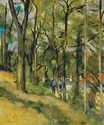Paul Cézanne - The orchard 1877
 |
 |
 |
 |
 |
 |
 |

The orchard 1877
oil/canvas
Museum of Fine Arts Saint Petersburg, Florida
<< Previous G a l l e r y Next >>
From Museum of Fine Arts Saint Petersburg, Florida:
Cézanne struggled to emphasize both surface and spatial depth in his painting. Using primarily a palette knife, Cézanne constructed a dense surface in paint emphasizing the horizontal, vertical, and diagonal in the landscape with planes of color and contour lines. This work, also known as Oxen Hill, was painted in the Paris suburb Pontoise. While there, the Impressionist painter Pissarro encouraged the development of Cézanne’s mature style. His art was built on Impressionism and he sought permanence and solidity of form using the cone, sphere, and cylinder to depict nature. He achieved a new formal structure in painting that contributed to a reformulation of Western pictorial conventions. A post-Impressionist, like Gauguin, whose impact was later influential in the development of Cubism, Cézanne is considered “the father of modern art.”